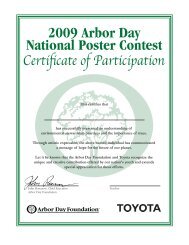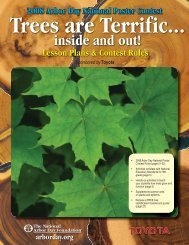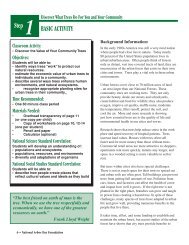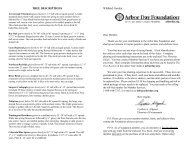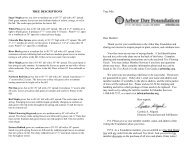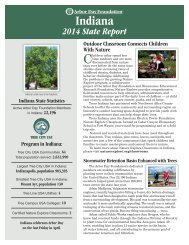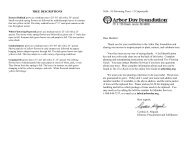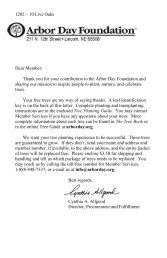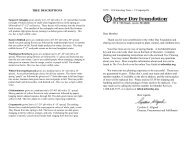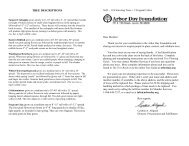Tree Diversity Activity - Arbor Day Foundation
Tree Diversity Activity - Arbor Day Foundation
Tree Diversity Activity - Arbor Day Foundation
You also want an ePaper? Increase the reach of your titles
YUMPU automatically turns print PDFs into web optimized ePapers that Google loves.
<strong>Tree</strong> <strong>Diversity</strong><br />
<strong>Activity</strong><br />
A Classroom <strong>Activity</strong> from The National <strong>Arbor</strong> <strong>Day</strong> <strong>Foundation</strong>
You and your class may have participated recently in the<br />
Vote for America’s National <strong>Tree</strong>, an historic opportunity<br />
for the people of the United States to choose a national<br />
symbol.<br />
While the national tree should represent the history and<br />
diversity of our country, the tree that may come to<br />
represent our nation may not be the best trees to plant in<br />
your backyard or at your school. Selecting the right tree for<br />
the right place is an important part of ensuring a tree's<br />
survival for years to come.<br />
In this activity you will have an opportunity to design a<br />
community forest and discover the importance of tree<br />
diversity.
Step1<br />
Discover the importance of tree diversity in a community<br />
BASIC ACTIVITY<br />
Instructional<br />
Design a healthy, diverse<br />
community forest<br />
Classroom <strong>Activity</strong>:<br />
• Using available worksheets, students will<br />
design a diverse community forest landscape<br />
plan.<br />
Objective:<br />
• Students will apply knowledge of specific<br />
trees' growth characteristics, landscape<br />
functions, and site requirements as they design<br />
a diverse community forest landscape plan.<br />
Time Recommended:<br />
• One 50-60 minute class period.<br />
Materials Needed:<br />
• Copies of worksheets provided<br />
• Scissors<br />
• Glue or glue sticks<br />
• Ruler<br />
National Science Standard Correlation:<br />
• Design a solution or product in light of the<br />
information at hand.<br />
Common <strong>Tree</strong> Shapes<br />
Sequence:<br />
Assess your students' prior knowledge and awareness<br />
of trees by asking how many different types of<br />
trees each student sees when coming to school.<br />
Record the responses, without comment, on the board.<br />
Ask students how they can tell the different trees<br />
apart. Responses will vary. Some leading questions<br />
to ask could include:<br />
Does the tree have special fruits or seeds?<br />
Does the tree have a unique shape?<br />
Are the leaves broad and flat or needle-like?<br />
Does the tree shed its leaves annually (deciduous)?<br />
What does the bark look like?<br />
Hand out copies of the <strong>Tree</strong> Information<br />
Worksheets to each student. Explain to students that<br />
they are going to create a community forest landscape<br />
plan by selecting trees to "plant" in designated<br />
locations. Knowing how to properly plant a tree is<br />
important, but planting the right tree in the right<br />
place is essential if you wish to enjoy that tree for<br />
decades to come. Explain that in selecting the appropriate<br />
tree for a location there are several important<br />
things to consider.<br />
Concept #1: Without variation, one disease or<br />
insect could destroy all the trees in a community.<br />
Explain that insect pests and disease organisms<br />
can affect almost any tree, but usually these are not<br />
life threatening. Occasionally, a disease or pest will<br />
appear and almost completely destroy a particular<br />
tree species.<br />
For instance, the American elm was once the most<br />
commonly planted street tree in North America. A<br />
fungus called Dutch Elm Disease found its way to the<br />
United States and spread across the nation killing<br />
millions of elm trees and leaving many cities almost<br />
treeless. Planting a variety of trees prevents one<br />
disease from destroying all the trees in a community.<br />
Columnar<br />
Pyramidal V-Shaped Round Oval Weeping<br />
National <strong>Arbor</strong> <strong>Day</strong> <strong>Foundation</strong> •
Ask students to identify a tree species on their<br />
worksheet that has problems with pests or disease.<br />
Answer: Lombardy poplar.<br />
Lombardy poplars were once commonly planted<br />
because of their unique columnar shape and rapid<br />
growth rate. Today, they are affected by a canker that<br />
causes trees to die within the first ten years. Because<br />
of their disease problems, Lombardy poplars are not<br />
recommended for planting.<br />
Concept #2: <strong>Tree</strong>s come in different shapes and sizes.<br />
If given enough space to grow, trees have characteristic<br />
shapes. Some shapes fit better in a space than<br />
others. Because of their v-shape, when hackberries<br />
are planted across the street from each other, their<br />
crowns form a cathedral-like arch over the street. A<br />
tree with a rounded crown will shade your backyard.<br />
Pyramidal-shaped trees with dense persistent<br />
leaves provide less shade, but are better at breaking<br />
the wind nearer the ground. A pyramidal-shaped tree<br />
also takes up more space near the ground. This means<br />
less lawn to mow, but also less space to play.<br />
Ask students to look at the "Key to Shapes" on the<br />
bottom of their worksheet. Have them identify the<br />
shapes of the trees listed.<br />
USDA Hardiness Zones<br />
Size is also important in tree selection. Knowledge<br />
of whether a two-foot seedling will grow into a 30' tree<br />
with a 20' spread or a 100' tree with a 70' spread is<br />
critical in deciding where to plant that seedling. <strong>Tree</strong>s<br />
too large for a particular site can quickly crowd a<br />
house, block a view, or get tangled in power lines.<br />
Ask students to identify which trees on the worksheet<br />
will grow to be the largest?...the smallest?<br />
Concept #3: Some trees are suited to certain<br />
locations, temperatures, and soils.<br />
Discuss with students that it is important not only<br />
to determine if the tree fits the location, but if the<br />
location provides what the tree needs to survive. Do<br />
the environmental factors of the location provide<br />
conditions that the tree needs to grow.<br />
Ask students to think what some of these environmental<br />
conditions could be.<br />
Environmental factors include:<br />
Temperature: The average lowest temperature of<br />
the year limits the range of many trees. The USDA<br />
has a "hardiness map" with the country zoned into<br />
regions based on temperature. Using this map, you<br />
can determine if a particular tree will survive the<br />
climate where you live. If time permits, determine<br />
what zone your community is in.<br />
Average Annual<br />
Minimum<br />
Temperature<br />
2 -50 to -40<br />
3 -40 to -30<br />
4 -30 to -20<br />
5 -20 to -10<br />
6 -10 to 0<br />
7 0 to 10<br />
8 10 to 20<br />
9 20 to 30<br />
10 30 to 40<br />
• National <strong>Arbor</strong> <strong>Day</strong> <strong>Foundation</strong>
Step 1: Discover the importance of tree diversity in a community- BASIC ACTIVITY<br />
Soil and Moisture: Each tree species can tolerate<br />
wet or dry growing conditions to a different degree.<br />
Some species do better in sandy soils. Some grow<br />
better in rocky or clay-like soils. The soil in parking<br />
lots often contains a great deal of salt from winter deicing.<br />
The salt can affect growing conditions for many<br />
kinds of trees. Honeylocust is a tree that is very<br />
tolerant of many soil conditions, as well as salt.<br />
Light: Another important environmental factor to<br />
consider is the amount of light the tree needs to grow.<br />
Some tree species, like white birch and most pines,<br />
require full sunlight to grow. Other species are more<br />
shade tolerant. Do not make the mistake of planting a<br />
tree where it is mismatched with its need for light.<br />
Air pollution: Chemicals in the air vary from<br />
location to location. Some trees are more tolerant than<br />
others of air pollution.<br />
Have students look at the "Key To Ideal Site<br />
Conditions" at the bottom of their worksheet.<br />
Ask students to identify a tree that requires full<br />
sun... one that is shade tolerant. Select a tree that<br />
requires a wet soil to grow... one that is tolerant of<br />
many different soil conditions.<br />
Concept #4: A greater diversity of trees means a<br />
greater diversity of wildlife.<br />
<strong>Tree</strong>s play an important role in the web of life that<br />
exists in a rural or urban forest. They provide food<br />
and shelter to a variety of wildlife. Certain tree<br />
species can determine the insect, bird, and even some<br />
mammal populations that exist in an area. Without<br />
that tree, the dependent organism would not be<br />
present.<br />
Proper selection of trees and plants can provide<br />
beauty and shade and, at the same time, provide a<br />
haven for wildlife. The presence of wildlife can make a<br />
backyard or woodlot a special place for your family. As<br />
urban and suburban development displaces many<br />
birds and animals from their natural habitat, it<br />
becomes increasingly important for landowners to<br />
provide mini-sanctuaries for wild birds and other<br />
wildlife. Some of the basics to consider when planting<br />
for wildlife include:<br />
Provide food: a wide variety of trees with high food<br />
value is the single best way to increase your wildlife<br />
viewing pleasure. Students should be reminded that<br />
when planting for wildlife, think about a variety of<br />
trees that will offer food for the animal year round.<br />
• Summer Fruit - Cherries, Dogwoods, Plums,<br />
Apricots<br />
• Fall and Winter Fruit - Apples, crabapples,<br />
Dogwoods, Hackberry, Hawthorn, Mountain ash<br />
• Seeds - Ashes, Birches, Firs, Hemlock, Maples,<br />
Spruces, Sweetgum<br />
• Nuts and Acorns - Butternut, Walnut, Chestnut,<br />
Hazelnut, Hickory, Oaks, Pecan<br />
Provide cover: Birds and small animals need<br />
concealed spaces for nesting and hiding to protect<br />
them from the eyes of predators. Planting conifers in<br />
groups, growing hedges with low branches, or using<br />
prickly or thorny plants in a<br />
few areas are all ways to<br />
provide wildlife cover.<br />
Using their worksheet,<br />
have students identify some<br />
of the tree species that are<br />
beneficial to wildlife.<br />
Ask students what kinds<br />
of wildlife they would like to<br />
attract . What are some<br />
benefits and disadvantages<br />
of attracting wildlife.?<br />
An example could include<br />
the fun of bringing many<br />
bird species to your backyard<br />
versus attracting large<br />
numbers of birds to city<br />
streets where bird droppings<br />
get on parked cars and<br />
business signs.<br />
National <strong>Arbor</strong> <strong>Day</strong> <strong>Foundation</strong> •
Step 1: Discover the importance of tree diversity in a community- BASIC ACTIVITY<br />
The <strong>Activity</strong>:<br />
Concept #5: <strong>Diversity</strong> provides aesthetic value<br />
and stimulation.<br />
<strong>Tree</strong>s provide beauty and add value to a landscape.<br />
<strong>Tree</strong>s simply make our lives more pleasant. They line<br />
our streets, cool our air, trap dust, muffle noise, shield<br />
us from wind, shade our parks, screen unattractive<br />
sites and bring wildlife to our backyard. <strong>Tree</strong>s provide<br />
social benefits. Hospital patients have been shown to<br />
recover from surgery more quickly when their room<br />
offered a view of trees.<br />
Some tree species have showy spring flowers.<br />
Others have spectacular fall color. Certain trees have<br />
tasty fruit, while others have fragrant needles or<br />
leaves. Planting different kinds of trees enhances the<br />
community landscape throughout the year.<br />
Ask students to describe the benefits we receive from<br />
trees. Record the responses on the board. If not<br />
mentioned by the students, included the benefits listed<br />
above.<br />
Have the students once again refer to their<br />
worksheet. Have them look at the diversity among the<br />
leaf shapes and the fruit produced.<br />
Ask them to identify which trees are broadleaf<br />
(deciduous-shedding all leaves annually) and which<br />
trees are conifers (cone bearing and usually evergreen).<br />
Ask them to desribe the leaf shapes on the various<br />
trees.<br />
Provide the opportunity for students to apply<br />
the information learned by designing a community<br />
forest landscape plan.<br />
Pass out the <strong>Tree</strong> Selection and Community<br />
Landscape Plan Worksheets. Using data from the<br />
<strong>Tree</strong> Information Worksheet and recalling the<br />
previously discussed concepts, students are to<br />
determine what tree to plant in each lettered<br />
location. Students cut the selected trees from the<br />
<strong>Tree</strong> Selection Sheet and glue them at the tree<br />
planting site they have chosen.<br />
Some trees are suitable for several locations.<br />
Some trees, like the Lombardy poplar, should not<br />
be planted because of the current problems it has<br />
with disease.<br />
When the landscaping projects are complete,<br />
ask students to explain their landscaping plans<br />
and their reasoning behind their selections.<br />
Provide the opportunity for peer review and<br />
redesign.<br />
Authentic Assessment:<br />
Ask students to look at tree plantings around the<br />
school building. Determine if these trees were good<br />
choices for the sites in which they were planted.<br />
Worksheets to copy:<br />
• <strong>Tree</strong> Information Sheet - Side A & B<br />
• <strong>Tree</strong> Selection Sheet<br />
• Community Landscape Plan Worksheet<br />
• National <strong>Arbor</strong> <strong>Day</strong> <strong>Foundation</strong>
1<br />
Douglasfir<br />
Height: 50 to 100 ft.<br />
Spread: 20 feet<br />
Growth Rate: medium<br />
Fruit: cone<br />
Comments: an important<br />
timber tree; can grow to over<br />
200' in a natural setting.<br />
Value to Wildlife: medium<br />
Attracts: birds, mammals<br />
<strong>Tree</strong> Information Sheet — Side A<br />
2<br />
Lombardy Poplar<br />
Height: 70 to 90 ft.<br />
Spread: 10 to 15 ft.<br />
Growth Rate: fast<br />
Fruit: no fruit, male clones<br />
Comments: has serious<br />
problems with insect pests.<br />
Value to Wildlife: low<br />
3<br />
Red Maple<br />
Height: 50 to 60 ft.<br />
Spread: 40 feet<br />
Growth Rate: medium<br />
Fruit: winged seed<br />
Comments: has beautiful red<br />
fall color.<br />
Value to Wildlife: low<br />
4<br />
Ginkgo<br />
Height: 50 to 80 ft.<br />
Spread: 30 to 40 ft<br />
Growth Rate: medium<br />
Fruit: naked, smelly seed<br />
Comments: yellow fall color.<br />
Because of smelly fruit, plant<br />
male trees.<br />
Value to Wildlife: low<br />
5<br />
Norway Spruce<br />
Height: 60 feet<br />
Spread: 25 feet<br />
Growth Rate: medium<br />
Fruit: cone<br />
Comments: ideal windbreaker<br />
Value to Wildlife: low<br />
7<br />
Weeping Willow<br />
Height: 30 to 40 ft.<br />
Spread: 35 feet<br />
Growth Rate: medium<br />
Fruit: small capsule<br />
Comments: graceful tree with<br />
ground sweeping branches.<br />
Value to Wildlife: low<br />
Key to Ideal Site Conditions:<br />
Full Sun<br />
Shade<br />
Tolerant<br />
Dry soil<br />
Average soil<br />
Moist soil<br />
Wet soil<br />
Wide range<br />
Key to <strong>Tree</strong> Shapes:<br />
6<br />
8<br />
White Oak<br />
Height: 80 to 100 ft.<br />
Spread: 60 to 80 ft<br />
Growth Rate: slow<br />
Fruit: acorn<br />
Comments: a majestic tree, it<br />
does not do well in city<br />
conditions.<br />
Value to Wildlife: high<br />
Attracts: birds, mammals<br />
Green Ash<br />
Height: 50 to 60 ft.<br />
Spread: 25 feet<br />
Growth Rate: Fast<br />
Fruit: winged seed<br />
Comments: very hardy tree,<br />
leaves turn yellow in fall.<br />
Value to Wildlife: Low to<br />
medium<br />
Attracts: birds<br />
Columnar Pyramidal V-Shaped Round Oval Weeping<br />
National <strong>Arbor</strong> <strong>Day</strong> <strong>Foundation</strong> •
9<br />
Hackberry<br />
Height: 40 to 70 ft.<br />
Spread: 50 feet<br />
Growth Rate: fast<br />
Fruit: hard, berrry-like seed<br />
Comments: grows easily,<br />
leaves sometimes get wart-like<br />
galls.<br />
Value to Wildlife: high<br />
Attracts: birds, small mammals<br />
<strong>Tree</strong> Information Sheet — Side B<br />
10<br />
Scotch Pine<br />
Height: 60 feet<br />
Spread: 40 feet<br />
Growth rate: medium<br />
Fruit: cone<br />
Comments: a commonly<br />
planted Christmas tree.<br />
Value to Wildlife: low<br />
11<br />
Horsechestnut<br />
Height: 50 to 75 ft.<br />
Spread: 40 to 70 ft.<br />
Growth Rate: medium<br />
Fruit: spiny capsules<br />
with nuts<br />
Comments: has white flowers in<br />
the spring.<br />
Value to Wildlife: moderate<br />
Attracts: small and large mammals<br />
12<br />
Honeylocust<br />
Height: 40 to 70 ft.<br />
Spread: 50 feet<br />
Growth Rate: fast<br />
Fruit: pod<br />
Comments: tolerant of salt and<br />
most soils. Select a thornless<br />
variety for planting.<br />
Value to Wildlife: moderate<br />
Attracts: large mammals<br />
Redbud<br />
Height: 20 to 30 ft.<br />
Spread: 20 to 30 ft.<br />
Growth Rate: medium<br />
Fruit: pod<br />
Comments: has pretty purple<br />
blooms in spring.<br />
Value to Wildlife: low<br />
13 14<br />
Hawthorn<br />
Height: 25 to 30 ft.<br />
Spread: 25 feet<br />
Growth Rate: slow<br />
Fruit: berry<br />
Comments: sharp thorns; fruit remains<br />
on tree into winter, attracting birds<br />
Value to Wildlife: moderate<br />
Attracts: birds<br />
15<br />
White Birch<br />
Height: 40 to 50 ft.<br />
Spread: 25 feet<br />
Growth Rate: medium/fast<br />
Fruit: catkin<br />
Comments: has lovely white<br />
bark; often grown in groups.<br />
Value to Wildlife: medium<br />
Attracts: birds<br />
Key to Ideal Site Conditions:<br />
Full Sun<br />
Shade<br />
Tolerant<br />
Dry soil<br />
Average soil<br />
Moist soil<br />
Wet soil<br />
Wide range<br />
16<br />
Key to <strong>Tree</strong> Shapes:<br />
Redcedar<br />
Height: 40 to 50 ft.<br />
Spread: 20 feet<br />
Growth Rate: medium<br />
Fruit: berry-like cone<br />
Comments: excellent for<br />
windbreaks; birds love berries.<br />
Value to Wildlife: high<br />
Attracts: birds, small mammals<br />
Columnar Pyramidal V-Shaped Round Oval Weeping<br />
• National <strong>Arbor</strong> <strong>Day</strong> <strong>Foundation</strong>
<strong>Tree</strong> Selection Sheet<br />
1<br />
2<br />
3<br />
4<br />
5<br />
6<br />
2–LOMBARDY<br />
POPLAR<br />
3–RED MAPLE<br />
4–GINKGO<br />
5–NORWAY<br />
SPRUCE<br />
6–WHITE OAK<br />
1–DOUGLASFIR<br />
7<br />
8<br />
9<br />
10<br />
11 12<br />
7–WEEPING<br />
WILLOW<br />
8–GREEN ASH<br />
9–HACKBERRY<br />
10-SCOTCH<br />
PINE<br />
11–HORSE-<br />
CHESTNUT<br />
12–HONEY-<br />
LOCUST<br />
13 14<br />
15<br />
16<br />
✁<br />
Assignment:<br />
13–REDBUD<br />
Beautify a community.<br />
Using what you have<br />
learned as well as data<br />
from the <strong>Tree</strong> Information<br />
Sheet, select the best tree<br />
to plant in each site on<br />
the Community Landscape<br />
Plan Worksheet.<br />
14–HAWTHORN<br />
15–WHITE BIRCH<br />
16–REDCEDAR<br />
Site A — Needs a medium-sized tree that will grow well in a sunny front yard.<br />
Site B — Needs a tree that will provide shade and leave room near the ground for kids to play<br />
in a backyard.<br />
Site C — Needs a street-side tree that will fit under a power line.<br />
Site D — Needs a tree that will be attractive through all seasons.<br />
Site E — Needs a tree that can tolerate poor soil and salt from winter de-icing in a parking lot.<br />
Site F — Needs a tree that can help break the wind just west of a farmhouse.<br />
Site G — Needs a large shade tree under which people can picnic and relax that will also<br />
benefit wildlife.<br />
Site H — Needs a tree that will grow in wet soil near a wetlands area.<br />
Site I — Needs a medium-sized tree that will grow in a variety of soil conditions.<br />
Site J — Needs a tree that will attract birds to a narrow space outside a classroom window.<br />
Planting <strong>Tree</strong>s<br />
Around Your<br />
House<br />
Wrong<br />
Large trees planted under utility lines can interfere with<br />
lines. Evergreens planted too close to the house can block<br />
warming winter sunlight and restrict views. Also, avoid<br />
planting large trees near gardens or chimneys.<br />
Better<br />
Short flowering trees don't clash with overhead lines. Large<br />
deciduous trees on the southeast, southwest, and west<br />
provide cooling shade in summer and don't obstruct the low<br />
winter sun. An evergreen windbreak on the north blocks cold<br />
winter winds and provides a home for wildlife.<br />
National <strong>Arbor</strong> <strong>Day</strong> <strong>Foundation</strong> •
F<br />
A<br />
H<br />
Park<br />
B<br />
C<br />
G<br />
S<br />
N<br />
E<br />
Apartments<br />
E<br />
D<br />
Parking Lot<br />
Farm<br />
Pond<br />
Wetlands<br />
H<br />
W<br />
Community Landscape Plan Worksheet<br />
Business<br />
School<br />
I<br />
J<br />
• National <strong>Arbor</strong> <strong>Day</strong> <strong>Foundation</strong>



